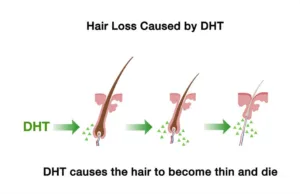DHT

DHT is the main cause of hair loss DHT is the main cause of hair loss in men and partly in women. In men, hair loss is caused by the hormone dihydrotestosterone (DHT), a male steroid hormone that binds receptors on the scalp of genetically susceptible men. DHT may seem complicated, but its role in hair loss is relatively easy to understand once you have a basic understanding of how your body produces DHT and its effects on your hair follicles. Below we explain what DHT is, how it is produced by your body and the options available to limit the negative effects of DHT on your hairline.
What is DHT?
DHT, or dihydrotestosterone, is an androgen produced as a by-product of testosterone. DHT is a powerful male sex hormone responsible, among other things, for the development of male genitalia during pregnancy. In short, DHT is one of the many hormones that shape the human body, but it is different from other male sex hormones. Testosterone is important in many ways.
DHT and hereditary hair loss
If you are genetically predisposed to hair loss, DHT can bind to receptors in the hair follicles and cause them to shrink, weaken and eventually die. DHT limits the ability of the follicles to produce new hair and prevents essential nutrients such as proteins, vitamins and minerals from reaching the follicles. This results in a process called 'miniaturisation', which leads to a gradual slowdown in hair growth in the DHT-affected follicles. The hair becomes thinner and shorter as the hair growth cycle is shortened. Sometimes the growth cycle is so short that new hair does not reach the surface of the skin.
DHT in our bodies
Interestingly, DHT is an important hormone for hair growth on other parts of the body, meaning that the same hormone that causes hair loss on the head is also responsible for hair growth on the chest, back and other areas. DHT is the primary hormone that causes hair loss in men, so the most effective way to slow or prevent hair loss is to block DHT. Many people choose to treat it with a DHT-blocking shampoo or spray, even if it doesn't block DHT completely.
A man may notice that he has too much DHT
By experiencing various symptoms related to the excess of this hormone. Some of the most common symptoms of too high levels of DHT include:
- Increased hair loss: One of the most obvious signs of too much DHT is increased hair loss, especially on the head. This can lead to hair thinning and a faster than normal rate of hair loss.
- Increased hair growth on the body: Excess DHT can also lead to increased hair growth on other parts of the body such as the chest, back and face.
- Acne: Too much DHT can also cause an increase in sebum production in the skin, which can lead to increased acne or oily skin.
- Enlarged prostate: In older men, excess DHT can lead to an enlarged prostate gland, which can cause problems with urination and other urine-related issues.
Some of the possible effects of too high levels of DHT in women include:
- Increased hair growth: As in men, excess DHT in women can lead to increased hair growth in unwanted areas such as the face, chest or back.
- Hair loss: As in men, excessive levels of DHT in women can cause hair loss, resulting in thinning hair or increased baldness.
- Changes in the menstrual cycle: Excess DHT can affect hormonal balance in women and lead to irregular menstrual cycles or other menstrual-related problems.
- Acne: As in men, too much DHT can cause increased sebum production in the skin, which can lead to acne or oily skin in women.
Finasteride and DHT
According to a study published in the Journal of American Academy of Dermatology, Finasteride in combination with Minoxidil is the most effective treatment for slowing and stopping male pattern hair loss. Finasteride was originally designed as a treatment for prostate enlargement, but it was discovered during the medical research process that it also had a significant effect on male pattern baldness.
DHT and female hair loss
Women can also suffer from DHT-related hair loss, which can be linked to genetic factors, hormonal changes or the use of certain medications. This type of hair loss in women can be treated with drugs that reduce DHT levels or block its effects to promote hair growth. However, it is important that women experiencing hair loss consult a doctor to determine the best treatment plan for their specific situation.
DHT blockers
The most effective way to block DHT is through drugs that block its production or activity in the body. DHT blockers are used to treat conditions such as male pattern hair loss and benign prostatic hyperplasia by reducing the levels of DHT, thereby relieving symptoms and improving the quality of life of affected individuals. However, it is important to use DHT blockers with caution and under the supervision of a doctor due to possible side effects and its impact on other hormonal processes in the body.
Side effects of blocking DHT
Most people experience no noticeable side effects from DHT blockers, but some may experience increased levels of testosterone in the body. In a small percentage of men, it can also lead to reduced sex drive or weaker erections. These side effects tend to disappear when the medication is stopped. Blocking DHT is most effective when started early, before significant hair loss has occurred. So if you notice signs of hair loss, it is best to contact a doctor for advice and possible treatment.
In the case of hereditary hair loss the combination of Prp treatment and hair transplant become relevant.This is because there is an area on the back of a man's head that is not genetically sensitive to DHT. This is why hair transplants with these follicles provide such successful results.
